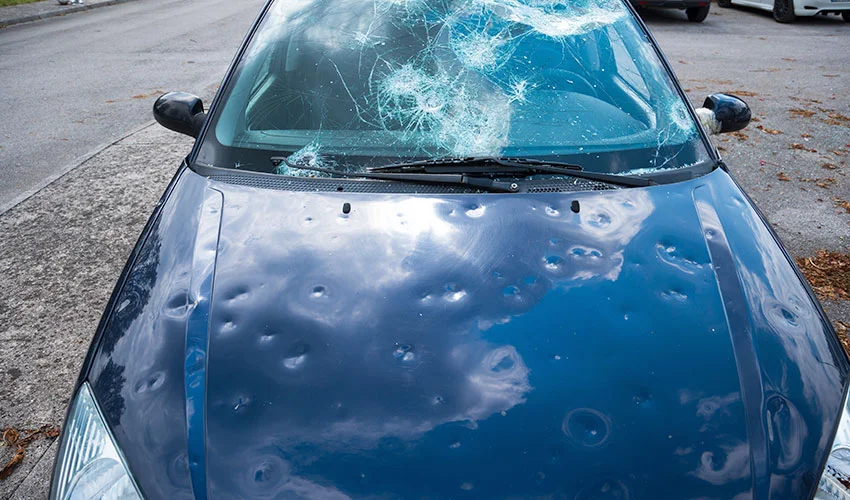Hailstorms in Colorado can cause significant damage to vehicles, leaving many car owners concerned about how to handle insurance claims. Knowing how to navigate the process and understanding your options is essential. This article will guide you through the steps of filing a hail damage claim, highlighting important factors such as repair options, insurance implications, and the timing of your claim.

[Key Points on Filing a Hail Damage Claim]
What is Hail Damage?
Hail damage occurs when hailstones, which are frozen raindrops, strike your vehicle. This can result in various types of damage, including dents, broken windows, and chipped paint. The extent of the damage depends on the size and velocity of the hailstones. In a state like Colorado, where hailstorms are common, this type of damage is a frequent concern for car owners.
How Long Do You Have to Claim Hail Damage in Colorado?
One of the most common questions after a hailstorm is, “How long do I have to file a claim?” The timeline for filing a claim can vary depending on your insurance provider. Most insurance companies do not impose a strict deadline but typically recommend filing within 30-60 days of the hailstorm.
While you might think you have ample time, it’s always better to file sooner rather than later. Delaying your claim can lead to issues such as:
- Additional Damage: If you continue to drive a hail-damaged vehicle, it could suffer further damage, making the claim process more complicated.
- Proof of Cause: The longer you wait, the harder it may be to prove that the hailstorm caused the damage, especially if additional wear and tear occurs in the meantime.
- Insurance Complications: Delayed claims can sometimes be viewed with suspicion by insurance companies, potentially leading to disputes or even denial of your claim.
The Role of Paintless Dent Repair (PDR) in Hail Damage
Paintless Dent Repair (PDR) is a common technique used to fix minor dents caused by hail without the need for repainting. This method is effective when the hail is small and the damage is light. Skilled technicians use specialized tools to gently massage the metal back into its original shape from underneath the panel.
However, PDR has its limitations. If the hailstones are large or heavy enough, they can create microscopic cracks in the paint. Once the paint is compromised, PDR is no longer an option. In such cases, the damaged area must be sanded and repainted to prevent rust and further deterioration. Ignoring these cracks can lead to more extensive damage over time.
What You Need to Know about Hail Damage and Insurance
When dealing with hail damage, understanding your insurance coverage and the implications of filing a claim is crucial.
- Totaling Your Car: In some cases, hail damage can be so severe that the cost of repairs exceeds the value of your car. When this happens, your insurance company may declare your car “totaled.” They will offer a settlement based on what they determine your car is worth. Before accepting the offer, it’s wise to consult with a professional body shop to ensure that the settlement is fair.
- Insurance Premiums: One common concern is whether filing a hail damage claim will raise your insurance rates. Generally, hailstorms are considered an “act of God,” which means they are natural events beyond your control. As a result, such claims typically do not lead to an increase in your insurance premiums. These claims fall under the comprehensive coverage portion of your policy, not collision.
The Importance of Timely Repairs
While most insurance companies do not require you to repair your vehicle immediately after making a hail damage claim, delaying repairs can lead to complications. If another hailstorm hits before you’ve fixed the existing damage, proving new damage becomes difficult. In such cases:
- Proving New Damage: You must demonstrate that additional damage occurred during the second storm. The insurance company will likely require you to pay another deductible and reassess the damage. They will then deduct the amount of the original payment from the new claim and pay the difference. Keep in mind that insurers may have underestimated the damage in the first claim, and they might do the same with the subsequent claim.
- Preventing Further Issues: Repairing hail damage before the next hail season is important. Not only does it prevent additional damage, but it also ensures that you’re fully covered if another storm occurs. Unrepaired damage could lead to rust, paint peeling, and other long-term problems.
Conclusion
Dealing with hail damage in Colorado can be a stressful experience, but understanding the process and your options can make it more manageable. Whether it’s filing your claim promptly, considering the limitations of Paintless Dent Repair, or understanding how hail damage can affect your insurance, being informed is your best defense.
Remember, filing your claim as soon as possible is key. Document the damage thoroughly, consult with your insurance provider, and don’t hesitate to seek professional advice if needed. By taking these steps, you can ensure that your vehicle is repaired correctly and that your insurance claim is handled smoothly.
References:
- Insurance Information Institute
- Colorado Department of Regulatory Agencies – Division of Insurance
- National Weather Service












